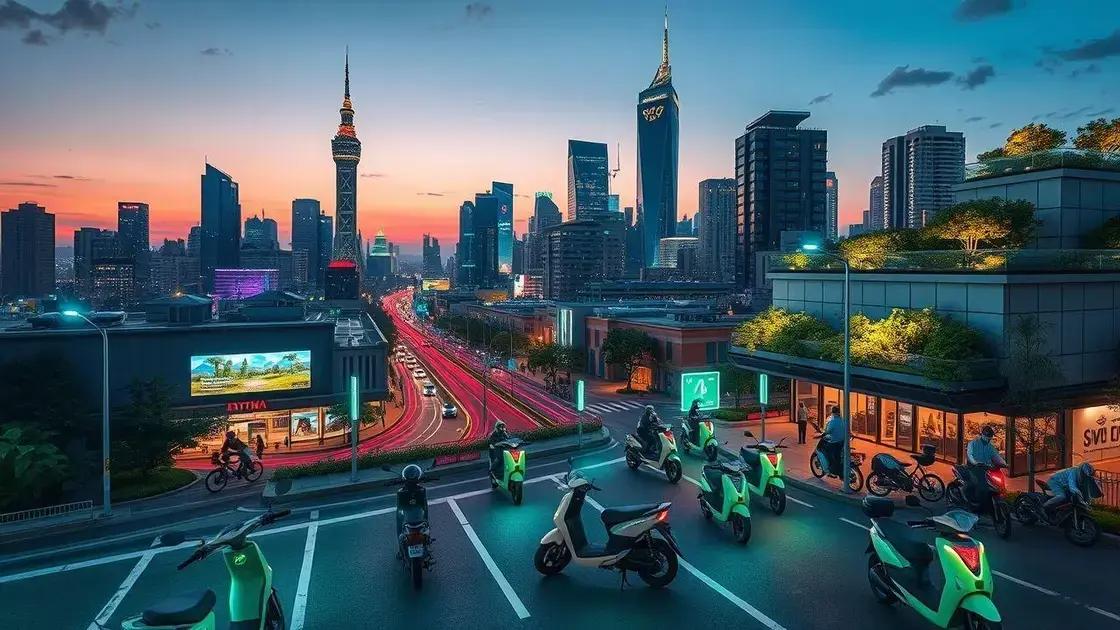Rise of micro-mobility services in urban centers

The rise of micro-mobility services in urban centers offers efficient, eco-friendly transportation solutions that reduce traffic congestion and emissions while promoting public health and sustainability.
The rise of micro-mobility services in urban centers is changing how we navigate our cities. With options like scooters and bikes, urban commuting becomes more accessible and flexible. Ever thought about how these services could impact your daily routine?
Understanding micro-mobility services
Understanding micro-mobility services is essential in today’s urban environment. These services are reshaping how people move around cities, offering convenient and eco-friendly options that can ease congestion.
Micro-mobility typically includes small, lightweight vehicles like electric scooters and bikes. They provide a fast and flexible alternative for travelers, especially over short distances.
Benefits of micro-mobility
Micro-mobility offers numerous advantages for urban commuters:
- Accessibility: Users can easily locate and rent vehicles through mobile apps.
- Cost-Effective: Generally, they are cheaper than owning a car or using public transport for short trips.
- Environmental Impact: These services reduce carbon footprints and promote sustainable transportation.
- Health Benefits: Riding bikes or scooters encourages physical activity.
Moreover, urban areas have started integrating micro-mobility into their infrastructure. Cities are creating dedicated lanes and parking spots, making it safer for users. As a result, more people feel comfortable using these services.
Challenges facing micro-mobility
Despite their benefits, micro-mobility services also face challenges, such as:
- Regulation: Cities must develop regulations that ensure safety without stifling innovation.
- Safety Concerns: Users may face risks from traffic, so promoting safety measures is crucial.
- Operating Costs: Companies must find a balance between offering affordable services and covering operational expenses.
As micro-mobility services continue to evolve, they may serve as a vital solution to urban transportation challenges. Understanding their role can help cities enhance mobility for everyone.
Benefits of micro-mobility in cities

The benefits of micro-mobility in cities are impactful and numerous. As urban areas grow, finding efficient ways to move around becomes essential. Micro-mobility offers a practical alternative, addressing many transportation issues.
One significant advantage is reduced traffic congestion. When more people opt for scooters or bikes instead of cars, traffic flows more smoothly. This change can lead to less frustration and shorter travel times. Additionally, it contributes to cleaner air and a healthier environment.
Cost-Effectiveness
Micro-mobility services are generally more affordable than traditional transportation. They allow users to save money on fuel, parking, and maintenance costs associated with owning a vehicle. Renting a bike or scooter for a short trip can cost just a few dollars.
- Convenience: Easily accessible through mobile apps.
- Economical: Saving money on transportation costs.
- Flexibility: Quick and easy to use for short distances.
Another critical benefit is improved public health. With more people cycling or scooting around, there is a higher level of daily physical activity, which promotes better health and fitness. Furthermore, these services encourage outdoor engagement and community interaction. More pedestrians and riders create vibrant public spaces.
Environmental Impact
Micro-mobility contributes positively to the environment by reducing greenhouse gas emissions. Traditional vehicles are a major source of pollution, while electric scooters and bikes produce zero emissions. This shift helps cities achieve sustainability goals.
As more micro-mobility options become available, cities are better positioned for growth and innovation in transportation. These services support smart urban planning, integrating seamlessly into existing public transport systems.
Challenges faced by micro-mobility services
The challenges faced by micro-mobility services are significant and require attention. As these services become more popular, understanding the obstacles they encounter is crucial for growth and sustainability. One major challenge is regulation. Governments must create rules that ensure safety while encouraging innovation.
In many cities, the lack of clear policies can hinder the expansion of micro-mobility options. Without guidelines, companies may struggle to operate effectively. Furthermore, different cities might have varying regulations, which adds complexity.
Safety Concerns
Another critical issue is the safety of riders. Accidents involving electric scooters or bikes can lead to injuries, which raises public concern. Ensuring safe operations requires dedicated bike lanes and proper signage to guide users.
- Infrastructure: Many cities lack adequate bike paths and lanes.
- Rider Education: Users need training on safe riding practices.
- Parking Issues: Improper parking can cause obstructions and conflicts with pedestrians.
Maintenance of the vehicles also poses a challenge. Scooters and bikes require regular upkeep to function correctly. Companies face costs related to charging and repairing vehicles, which can impact their profitability.
Public Acceptance
Furthermore, public acceptance can be a barrier. Some community members may be hesitant to embrace micro-mobility. Concerns about noise, safety, or clutter on sidewalks can lead to opposition. As more people become aware of the benefits, changing this perception will be essential.
Lastly, competition in the micro-mobility market is intense. New companies constantly enter the field, making it challenging for existing firms to maintain market share. Companies must differentiate their services to attract and retain customers.
Future trends in urban micro-mobility

The future trends in urban micro-mobility are exciting and full of potential. As cities continue to grow, the demand for efficient transportation solutions is more critical than ever. Micro-mobility options like e-scooters and electric bikes are expected to play a vital role in shaping urban transportation.
One emerging trend is the integration of micro-mobility with public transportation systems. This will allow commuters to seamlessly transition from buses or trains to scooters and bikes, creating a more cohesive travel experience. By providing easier connections, cities can improve overall mobility.
Technological Innovations
Technological advancements are also set to change the landscape of micro-mobility. Innovations such as smart parking solutions and improved battery technology will enhance user experiences. Smart systems can direct riders to available vehicles and help reduce congestion in crowded areas.
- Geolocation: Enhanced tracking to find nearby vehicles quickly.
- Battery Life: Longer-lasting batteries to increase utilization.
- Safety Features: New technologies to enhance rider safety and vehicle reliability.
Another trend is the focus on sustainability. As awareness of environmental issues grows, companies are prioritizing eco-friendly practices. Many are transitioning to electric vehicles and using recyclable materials in production. This shift not only helps the planet but also attracts conscious consumers.
Shared Mobility Trends
In addition, the rise of shared mobility platforms is expected to continue. Users are increasingly turning to shared services instead of owning personal vehicles. This trend reduces the total number of cars on the road and promotes community-based transportation solutions.
As cities adapt to these changes, regulations will need to evolve as well. Policymakers must create frameworks that support innovation while ensuring public safety. Collaborations between city officials and micro-mobility companies can lead to better outcomes.
Overall, the future of urban micro-mobility looks bright. With the right combination of technology, sustainability, and community engagement, cities can create more efficient and accessible transportation systems for all.
FAQ – Frequently Asked Questions about Micro-Mobility Services
What are micro-mobility services?
Micro-mobility services include small transportation options like electric scooters and bikes that provide convenient and eco-friendly solutions for short trips.
How do micro-mobility services benefit urban environments?
They reduce traffic congestion, lower emissions, and promote physical health by encouraging more people to cycle or scooter instead of driving.
What challenges do micro-mobility services face?
Common challenges include safety concerns, regulatory hurdles, and the need for proper infrastructure to support riders.
What trends are shaping the future of micro-mobility?
Future trends include integrating micro-mobility with public transport, embracing sustainability, and leveraging technological advancements to enhance user experiences.





